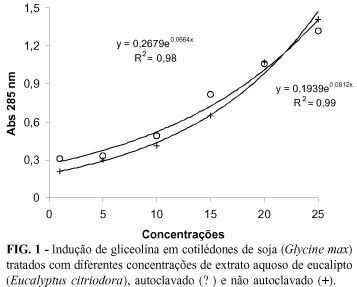Secondary compounds present in medicinal plants can play important roles in plant-pathogen interactions, through immediate antimicrobial action or by inducing a defence mechanism in other plants that may be treated with such compounds. With the objective of verifying the potential of Eucalyptus citriodora in the alternative control of anthracnose in cucumber (Cucumus sativus), aqueous extract (AE) of this forest essence, autoclaved or unautoclaved, in concentrations of 0,1, 1, 5, 10, 15, 20 e 25% was used in the following experiments: induction of phytoalexins in sorghum (Sorghum bicolor) etiolated mesocotyls and soybean (Glycine max) cotyledons; fungitoxicity in vitro against Colletotrichum lagenarium conidia; local or systemic induction of resistance in cucumber plants. Water and Bion were used as control treatments. The results indicated that the autoclaved and unautoclaved AE induced phytoalexin synthesis in sorghum starting from the concentration of 1%. In soybean, gliceollin synthesis took place in 10% and 15% of the autoclaved and unautoclaved AEs, respectively. There was total inhibition in the spores germination and apressoria formation in concentrations of 20% and 1% of the autoclaved AE, respectively. As for the unautoclaved extract, there was 75% inhibition of the spores germination in 25% of AE and total inhibition in the apressoria formation in 15% of AE. Based on the parameter size of lesion, the unautoclaved aqueous extract of E. citriodora could potentially induce local resistance in cucumber against C. lagenarium.







